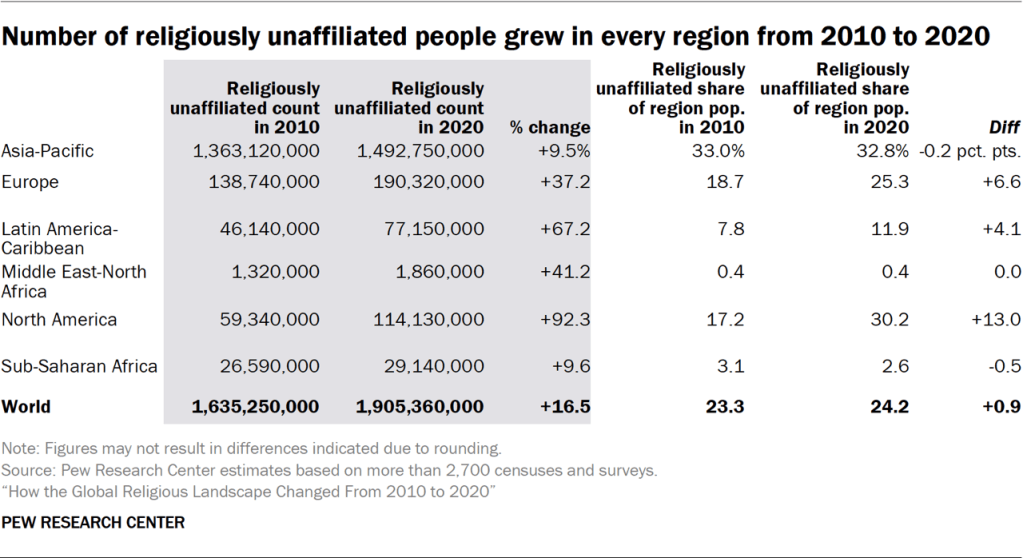The religiously unaffiliated population – often called religious “nones” – is the world’s third-largest religious category, after Christians and Muslims. This group includes people who in surveys and censuses answer a religious identity question by saying they do not have any religion or that they are atheist or agnostic.23
Between 2010 and 2020, religiously unaffiliated people grew more than any group except Muslims. The unaffiliated made up a majority of the population in 10 countries and territories in 2020, up from seven a decade earlier.
Many religiously unaffiliated people were raised with a religion but no longer identify with it in adulthood. This pattern is common in European and North American countries, as well as in Australia and New Zealand, where many people who were raised Christian no longer claim any religious affiliation.
Global change
Around the world, the number of people who say they have no religious affiliation grew by 17%, from 1.6 billion in 2010 to 1.9 billion in 2020. This outpaced the 11% increase among the religiously affiliated. Therefore, the religiously unaffiliated expanded as a share of the world’s total population, increasing from 23% in 2010 to 24% a decade later.

Regional change
Between 2010 and 2020, the number (or count) of religiously unaffiliated people grew in every region, and they grew faster than the religiously affiliated in every region except for the Asia-Pacific region and sub-Saharan Africa.

In North America, the unaffiliated population nearly doubled in size to 114 million (up 92%) between 2010 and 2020, while their numbers rose to 77 million in Latin America and the Caribbean (up 67%).
Over the same period, the number of people who claim no religious affiliation grew to 1.5 billion in the Asia-Pacific region and to 29 million in sub-Saharan Africa, up about 10% in both regions, slightly lagging behind the religiously affiliated population in these areas.
The percentage of people with no religious affiliation grew the most in North America, where religiously unaffiliated people make up 30% of the population (up 13 points), as of 2020. At the same time, the unaffiliated rose to a quarter of all Europeans (up 7 points) and 12% of residents of Latin America and the Caribbean (up 4 points). The share of the population that is religiously unaffiliated fell slightly in the Asia-Pacific region (down 0.2 points) and sub-Saharan Africa (down 0.5 points). It did not change in the Middle East-North Africa region.
Regional distribution of the religiously unaffiliated
As of 2020, the majority of people with no religious affiliation live in the Asia-Pacific region, mostly in China. (The Chinese government promotes atheism. Read about non-religion in China in our report “Measuring Religion in China.”)

About 78% of all religiously unaffiliated people worldwide reside in the Asia-Pacific region, down from 83% in 2010. This 5-point change was the largest among all regions and the only regional decrease larger than 0.1 point.
This drop was accompanied by increases in the shares of unaffiliated people living in North America, Europe and Latin America. As discussed earlier, there is widespread switching out of Christianity into the ranks of the unaffiliated in these places.
Europe now is home to 10% of the world’s “nones,” followed by North America (6%) and the Latin America-Caribbean region (4%).
Countries with the highest religiously unaffiliated counts
With nearly 1.3 billion religiously unaffiliated residents, China is home to about two-thirds of all the religiously unaffiliated people in the world. (China had the world’s largest total population in 2020, though it has since been surpassed by India.)
The United States has the second-largest unaffiliated population, yet the 101 million unaffiliated people in the U.S. make up only 5% of the global population of people with no religion.
Nearly 90% of all religious “nones” reside in 10 countries.

Where did the unaffiliated share of the population change the most?
The share of the population with no religious affiliation rose substantially (by at least 5 percentage points) in 35 countries. It did not decrease by 5 points or more anywhere in the world.
Countries that saw substantial increases in their religiously unaffiliated populations are found in every region except the Middle East and North Africa. Most are European nations that once had large Christian majorities and experienced corresponding decreases among Christians between 2010 and 2020. Disaffiliation from Christianity is a widespread, decades-long pattern seen in many places.
- The steepest growth occurred in Australia (up 17 points), followed by Chile (up 17 points) and Uruguay (up 16 points).
- The religiously unaffiliated population also rose substantially in the U.S. (up 13 points).
Substantial increases gave religiously unaffiliated people majority status in a few countries and territories. Ten places had an unaffiliated majority in 2020, up from seven in 2010. Most people in Uruguay, the Netherlands and New Zealand had no religious affiliation in 2020 – joining China, North Korea, the Czech Republic, Hong Kong, Vietnam, Macao and Japan, which were in this category in 2010.





